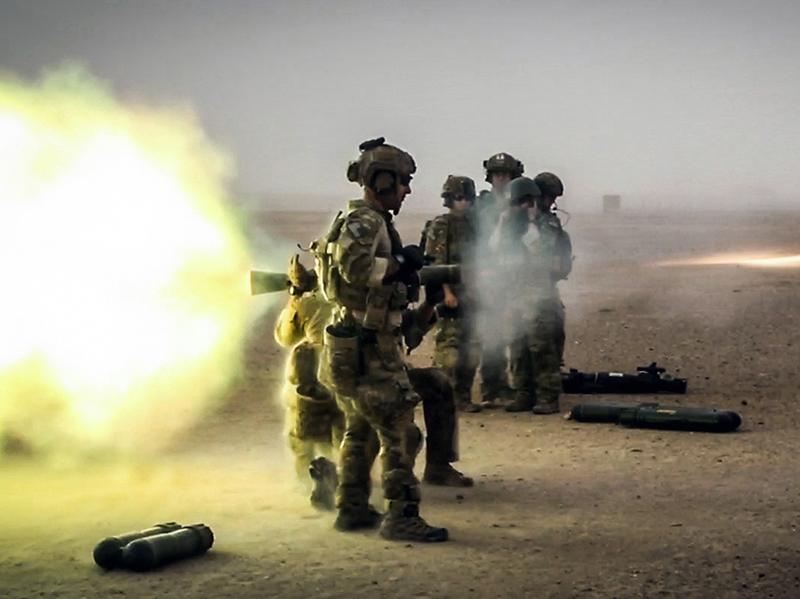 Morning Edition
Morning Edition
Do U.S. Troops Risk Brain Injury When They Fire Heavy Weapons?

The U.S. military is trying to figure out whether certain heavy weapons are putting U.S. troops in danger.
The concern centers on the possibility of brain injuries from shoulder-fired weapons like the Carl Gustaf, a recoilless rifle that resembles a bazooka and is powerful enough to blow up a tank.
A single round for the Carl Gustaf can weigh nearly 10 pounds. The shell leaves the gun's barrel at more than 500 miles per hour. And as the weapon fires, it directs an explosive burst of hot gases out of the back of the barrel.
For safety reasons, troops are trained to take positions to the side of weapons like this. Even so, they get hit by powerful blast waves coming from both the muzzle and breech.
"It feels like you get punched in your whole body," is the way one Army gunner described the experience in a military video made in Afghanistan. "The blast bounces off the ground and it overwhelms you."
During the wars in Iraq and Afghanistan, the military recognized that the blast from a roadside bomb could injure a service member's brain without leaving a scratch. Hundreds of thousands of U.S. troops sustained this sort of mild traumatic brain injury, which has been linked to long-term problems ranging from memory lapses to post-traumatic stress disorder.
Also during those wars, the military began to consider the effects on the brain of repeated blasts from weapons like the Carl Gustaf. And some members of Congress became concerned.
Rep. Louise Slaughter, a congresswoman from upstate New York and a member of the Congressional Brain Injury Task Force, says she was once told of a soldier whose ears bled after using the Carl Gustaf.
"Obviously," Slaughter says, "we have to know. What kind of damage is that doing to soldiers in training and on the battlefield?"
The military got some hints about the risks of firing heavy weapons from a program it launched in Afghanistan.
In 2011, the Army equipped thousands of troops with blast gauges — coin-sized sensors worn on the head and shoulders.
The gauges, made by a company in Slaughter's district, were designed to measure the intensity of a blast from a roadside bomb. But they also revealed worrisome levels of blast exposure in some troops who were merely firing certain heavy weapons.
Last year, the military quietly pulled the blast gauges from wide use, saying they hadn't been useful in detecting brain injuries. Slaughter thinks that was a mistake.
"I don't understand the Pentagon's circular argument," Slaughter says. "They aren't using the gauges because they don't have the data to prove how effective they are. But it doesn't take a great brain to understand you will not get the data if you don't use the gauges."
The military declined several requests for an interview about the blast gauge program and the risks from firing weapons.
But in an email, an Army spokesperson said that the Department of Defense is still using blast gauges in research, including some studies that look at "cumulative low-level blast" effects.
And a scientist who works for a private company hired by the military to study blast exposure confirms that ongoing research includes studies of exposures during weapons training.
"The reason that these studies are being done is that at some point someone has said, 'I don't feel quite right,' " says Laila Zai, director of neuroscience research at Applied Research Associates.
But it's really tricky to turn these anecdotes into usable data. Even results from the Army's blast-gauge program in Afghanistan are hard to interpret because there were so many variables on the battlefield, Zai says.
For example, she says, buildings and other structures tend to reflect blast waves from a weapon — and that can result in much greater exposure than when the weapon is fired in an open field.
So Zai has been working with a researcher from the Navy. "What he's doing is putting sensors on people undergoing shoulder-mounted weapons training," she says. "And he's looking to see if the overpressure [the force of a blast] generated by various training scenarios ever overwhelms the threshold of safety."
It's all part of a five-year, $30 million effort by the Office of Naval Research to help the military figure out how much blast exposure is too much.
Last year, a military study showed that firing heavy weapons could temporarily impair learning and memory. Now, Slaughter says, the military needs to find out whether these short-term effects can lead to long-term injuries among members of the service.
"If we can save them from a lifetime of brain damage," she says, "for heaven's sake, it's our obligation to do it."
9(MDEwODYxNTQyMDEzNjAxODk2Nzc2NzNmYQ001))